 W
WConstructivist architecture was a constructivist style of modern architecture that flourished in the Soviet Union in the 1920s and early 1930s. Abstract and austere, the movement aimed to reflect modern industrial society and urban space, while rejecting decorative stylization in favor of the industrial assemblage of materials. Designs combined advanced technology and engineering with an avowedly communist social purpose. Although it was divided into several competing factions, the movement produced many pioneering projects and finished buildings, before falling out of favour around 1932. It has left marked effects on later developments in architecture.
 W
WThe Aeroflot House is a constructivist building in Tsentralny District of Novosibirsk, Russia. It is located on the corner of Krasny Avenue and Yadrintsevskaya Street. The building was built in the 1930s.
 W
WASNOVA was an Avant-Garde architectural association in the Soviet Union, which was active in the 1920s and early 1930s, commonly called 'the Rationalists'.
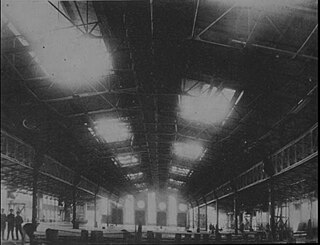 W
WBakhmetevsky Bus Garage was a public bus garage in Moscow, designed in 1926 by Konstantin Melnikov and Vladimir Shukhov. The building, completed in 1927, was an example of applying avant-garde architectural methods to an industrial facility. Neglected for decades and nearly condemned to demolition, it was restored in 2007–2008 and reopened in September 2008 as a gallery of modern art.
 W
WBaťa's Skyscraper, also known as Building No. 21, is a skyscraper in Zlín, Czech Republic. It is 77.5 metres high and has sixteen floors. It was the administration building of the Bata Shoes factory, a company that was based in the city. Now it is headquarters of the Zlín Region.
 W
WBolshoy Dom is an office building located at 4 Liteyny Avenue in Saint Petersburg, Russia. It is the headquarters of the local Saint Petersburg and Leningrad Oblast branches of the Federal Security Service of Russia (FSB) and Main Department of the Ministry of Internal Affairs.
 W
WBusiness House is a constructivist building in Tsentralny City District of Novosibirsk, Russia. It is located on the corner of Krasny Avenue and Lenin Street. The building is a part of the architectural ensemble of Lenin Square. It was built in 1928. Architects: D. F. Fridman, I. A. Burlakov.
 W
WCity Clinical Hospital No. 1 is a hospital in Zayeltsovsky District of Novosibirsk, Russia. It was founded in 1930. Many hospital buildings are built in the constructivist style.
 W
WCommunal House of the Textile Institute is a constructivist architecture landmark located in the Donskoy District of Moscow, Russia. The building, designed by Ivan Nikolaev to accommodate 2000 students, was erected in 1929-1931 and functioned as a student dormitory until 1996. As of August 2008, parts of the building are leased as office space, while the main residential block is abandoned and gutted inside; the current owner, Moscow Institute of Steel and Alloys, plans to rehabilitate the dilapidated structure into a modern campus.
 W
WThe Derzhprom or Gosprom building is a constructivist structure located in Freedom Square, Kharkiv, Ukraine. Its name is an abbreviation of two words that, taken together, mean State Industry. In English the structure is known as the State Industry Building or the Palace of Industry.
 W
WDinamo Residential Complex is a constructivist building complex in Tsentralny City District of Novosibirsk, Russia. It is located on the corner of Krasny Avenue and Oktyabrskaya Street. The complex was built in 1934–1936. Architects: Boris Gordeyev, S. P. Turgenev, V. N. Nikitin. It included a hotel and residential buildings for NKVD employees.
 W
WDinamo Sports Complex is a constructivist building in Tsentralny City District of Novosibirsk, Russia. It is located along Oktyabrskaya Magistral. The building was built in 1933. Architects: Boris Gordeyev, S. P. Turgenev, V. N. Nikitin.
 W
WThe Dnieper Hydroelectric Station is the largest hydroelectric power station on the Dnieper River, located in Zaporizhzhia, Ukraine. It is the fifth step of Dnieper hydroelectric stations cascade that provides electric power for Donets–Kryvyi Rih Industrial region.
 W
WThe Embassy of Russia in Havana is the headquarters of the diplomatic mission of the Russian Federation in the Republic of Cuba. It's well known for its striking constructivist building in the Miramar district of the city built by architect Aleksandr Rochegov. Some liken it to a sword, others to a syringe.
 W
WThe Gosbank Building is a constructivist building designed by Andrey Kryachkov. It is located on Krasny Avenue in Novosibirsk, Russia. The building is a part of the architectural ensemble of Lenin Square.
 W
WThe Government House or House of Government is a government building in Minsk located on Independence Square. It houses the National Assembly of Belarus and its two chambers: the Council of the Republic and the House of Representatives. The National Assembly is one of the highest organs of national power and symbolism in the country. It was built in 1934 and designed by Iosif Langbard. It stands behind a statue of Vladimir Lenin and is one of the few buildings that survived the Great Patriotic War.
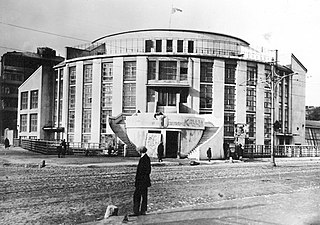 W
WKauchuk Factory Club is a 1927-1929 russian avant-garde public building designed by Konstantin Melnikov, located in Khamovniki District of Moscow, Russia on the edge of Devichye Pole park and medical campus at 64, Plyshikha Street.
 W
WKuzbassugol Building Complex is a building complex located in the Tsentralny City District of Novosibirsk, Russia. It was built in 1931–1933. Architects: B. A. Gordeyev, D. A. Ageyev, B. A. Bitkin.
 W
WThe linear city was an urban plan for an elongated urban formation. The city would consist of a series of functionally specialized parallel sectors. Generally, the city would run parallel to a river and be built so that the dominant wind would blow from the residential areas to the industrial strip. The sectors of a linear city would be:a purely segregated zone for railway lines, a zone of production and communal enterprises, with related scientific, technical and educational institutions,, a residential zone, including a band of social institutions, a band of residential buildings and a "children's band", a park zone, and an agricultural zone with gardens and state-run farms.
 W
WThe Lovell Beach House is located on the Balboa Peninsula in Newport Beach, California. The building was completed in 1926 and is now recognized as one of the most important works by architect Rudolf Schindler, second only to the Schindler House, built four years earlier for his family as a show house and studio. Both of these early houses by Schindler are considered landmarks of early modern architecture in America.
 W
WThe Mosselprom building is a monument to Russian constructivism and avantgarde architecture. It is located in the centre of Moscow on an intersection between Kalashny, Nizhny Kislovksy and Maly Kislovky side streets. It was designed by architect N. D. Strukov and is notable for its painted panels by the artists Alexander Rodchenko and his wife Varvara Stepanova.
 W
WThe Museum of Design, Zürich is a museum for industrial design, visual communication, architecture, and craft in Zurich, Switzerland.
 W
WThe Narkomfin Building is a block of flats at 25, Novinsky Boulevard, in the Central district of Moscow, Russia. Conceived as a "transitional type of experimental house", it is a renowned example of Constructivist architecture and avant-garde housing design.
 W
WThe National Bank of the Republic of Abkhazia, also known by the short form of Bank of Abkhazia is the central bank of the disputed region and partly recognized state of Abkhazia on the eastern coast of the Black Sea. It was established on February 28, 1991 since the adoption of the laws "On the National Bank of the Abkhaz SSR" and "On Banks and Banking of the Abkhaz SSR" passed by the Supreme Soviet of the Abkhaz SSR on February 28, 1991.
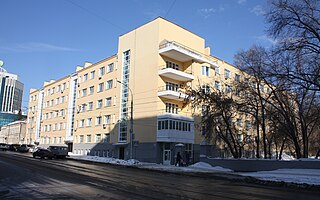 W
WNKVD House is a constructivist building in Tsentralny City District of Novosibirsk, Russia. It was built in 1932. Architects: Ivan Voronov, Boris Gordeyev.
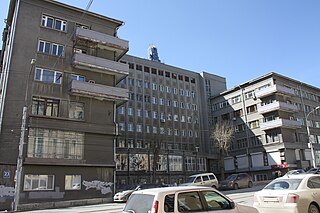 W
WNKVD House is a constructivist building in Tsentralny City District of Novosibirsk, Russia. It was built in 1936. Architects: Sergey Turgenev, Ivan Voronov, Boris Gordeyev.
 W
WNovoryazanskaya Street Garage, also spelled Novo-Ryazanskaya Street Garage, and known as "Horseshoe garage", was designed by Konstantin Melnikov and Vladimir Shukhov in 1926 and completed in 1929 at 27, Novoryazanskaya Street in Krasnoselsky District, Moscow, Russia, near Kazansky Rail Terminal.
 W
WNovosibirsk Chemical Engineering Technical School named after D. I. Mendeleev is an educational institution founded in 1929. The school is located between Nizhegorodskaya, Sacco and Vanzetti and Sadovaya streets in Oktyabrsky City District of Novosibirsk, Russia.
 W
WOctober Revolution House of Culture is a constructivist building in Zheleznodorozhny City District of Novosibirsk, Russia. It was built in 1927. The building is located on the corner of Lenin and Revolution streets. Architect: I. A. Burlakov.
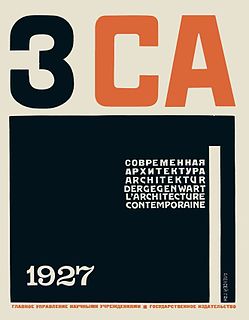 W
WThe OSA Group was an architectural association in the Soviet Union, which was active from 1925 to 1930 and considered the first group of constructivist architects. It published the journal SA. It published material by Soviet and overseas contributors. However this led to them being attacked as a 'Western' group and some individuals as being 'bourgeois'. After the closure of the group, their modernist approach to architecture and town planning was eliminated in the Soviet Union by 1934, in favour of social realism.
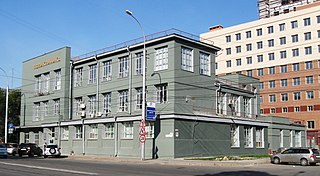 W
WThe Polyclinic No. 1 is a constructivist building designed by P. Shchyokin. It is located on Serebrennikovskaya Street in the Tsentralny City District of Novosibirsk, Russia.
 W
WThe Printing plant of Ogonyok magazine in Moscow, designed by El Lissitzky, is likely the only extant building based on Lissitzky's blueprints. Located at 55.777277°N 37.610828°E 17, 1st Samotechny Lane, it is Lissitzky's sole tangible work of architecture. It was commissioned in 1932 by Ogonyok magazine to be used as a print shop. In June 2007 the independent Russky Avangard foundation filed a request to list the building on the heritage register. In September 2007 the city commission (Moskomnasledie) approved the request and passed it to the city government for a final approval, which happened in August 2008. In October 2008, the abandoned building was badly damaged by fire. Next door, a developer Inteco has started preparations for construction of a new block of flats for the Film-Makers' Union.
 W
WPrombank Dormitory is a constructivist building in Tsentralny City District of Novosibirsk, Russia. It is located on the corner of Krasny Avenue and Kainskaya Street. The building was built in 1927. Architect: I. A. Burlakov.
 W
WRabochaya Pyatiletka was a constructivist building in Tsentralny City District of Novosibirsk, Russia. It was located on the corner of Kamenskaya and Chaplygin streets. The building was constructed in 1930.
 W
WThe Red Banner Textile Factory in Leningrad, Pionerskaya ulitsa, 53 was designed by Erich Mendelsohn and later partly redesigned by S. O. Ovsyannikov, E. A. Tretyakov, and Hyppolit Pretreaus. Built in 1926–1937.
 W
WThe Rusakov Workers' Club in Moscow is a notable example of constructivist architecture. Designed by Konstantin Melnikov, it was constructed in 1927–28. The club is built on a fan-shaped plan, with three cantilevered concrete seating areas rising above the base. Each of these volumes can be used as a separate auditorium, and combined they result in a capacity of over 1,000 people. At the rear of the building are more conventional offices. The only visible materials used in its construction are concrete, brick and glass. The function of the building is to some extent expressed in the exterior, which Melnikov described as a "tensed muscle".
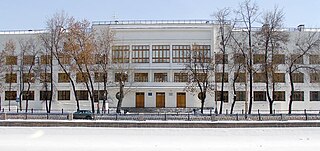 W
WSchool 518 is a high school in the historical Balchug area of Moscow, Russia. Designed by Ivan Zvezdin and completed in 1935, it is the only listed postconstructivist memorial building in the city. It was reconstructed between 1999 and 2003 to meet modern safety standards and Zvezdin's original design, both externally and internally.
 W
WThe Shukhov Radio Tower, also known as the Shabolovka Tower, is a broadcasting tower deriving from the Russian avant-garde in Moscow designed by Vladimir Shukhov. The 160-metre-high (520 ft) free-standing steel diagrid structure was built between 1920 and 1922, during the Russian Civil War.
 W
WThe Shukhov Tower on the Oka River is the world’s only diagrid hyperboloid transmission tower. It is located in Russia, in the western suburbs of Nizhny Novgorod, on the left bank of the Oka River near Dzerzhinsk. The tower is one of several structures designed by Russian engineer and scientist Vladimir Shukhov; its power lines, however, were decommissioned in 1989.
 W
WSoyuzzoloto Residential House is a constructivist building in Tsentralny City District of Novosibirsk, Russia. It is located on the corner of Kamenskaya and Oktyabrskaya streets. The building was constructed in 1932. Architects: A. I. Bobrov, B. A. Gordeyev.
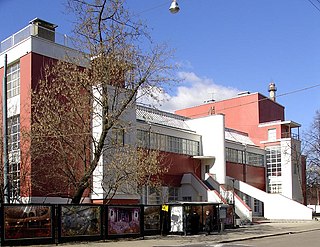 W
WSvoboda Factory Club, conceived as Chemists Trade Union Club, also known as Maxim Gorky Palace of Culture, is a listed memorial avant-garde building in Moscow, Russia, designed by Konstantin Melnikov in 1927 and completed in 1929. It is located at 41A, Vyatskaya Street, in Savyolovsky District.
 W
WTatlin's Tower, or the project for the Monument to the Third International (1919–20), was a design for a grand monumental building by the Russian artist and architect Vladimir Tatlin, that was never built. It was planned to be erected in Petrograd after the Bolshevik Revolution of 1917, as the headquarters and monument of the Comintern.
 W
WThe Tsentrosoyuz Building or Centrosoyuz Building is a government structure in Moscow, Russia, constructed in 1933 by Le Corbusier and Nikolai Kolli. Centrosoyuz refers to a Soviet bureaucracy, the Central Union of Consumer Cooperatives. The building included office space for 3,500 personnel, as well as a restaurant, lecture halls, a theater, and other facilities. The address of the building is 39 Myasnitskaya Street, and the eastern side of the building faces Myasnitskaya Street. The western side, which was supposed to be the main entrance, faces Academician Sakharov Avenue. Currently it is the home of Rosstat, Russian Federal State Statistics Service and Federal Financial Monitoring Service.
 W
WVkhutemas was the Russian state art and technical school founded in 1920 in Moscow, replacing the Moscow Svomas.
 W
WThe Zuyev Workers' Club in Moscow is a prominent work of constructivist architecture. It was designed by Ilya Golosov (1883–1945) in 1927 and finished in 1929. The building was designed to house various facilities for Moscow workers, and utilises an innovative glazing treatment at its corner which has proved very photogenic.